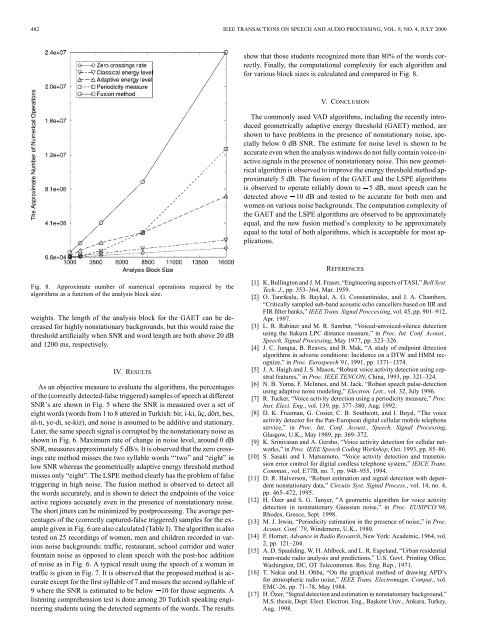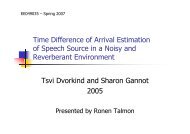Voice activity detection in nonstationary noise - Speech and ... - SIPL
Voice activity detection in nonstationary noise - Speech and ... - SIPL
Voice activity detection in nonstationary noise - Speech and ... - SIPL
You also want an ePaper? Increase the reach of your titles
YUMPU automatically turns print PDFs into web optimized ePapers that Google loves.
482 IEEE TRANSACTIONS ON SPEECH AND AUDIO PROCESSING, VOL. 8, NO. 4, JULY 2000show that those students recognized more than 80% of the words correctly.F<strong>in</strong>ally, the computational complexity for each algorithm <strong>and</strong>for various block sizes is calculated <strong>and</strong> compared <strong>in</strong> Fig. 8.V. CONCLUSIONThe commonly used VAD algorithms, <strong>in</strong>clud<strong>in</strong>g the recently <strong>in</strong>troducedgeometrically adaptive energy threshold (GAET) method, areshown to have problems <strong>in</strong> the presence of <strong>nonstationary</strong> <strong>noise</strong>, speciallybelow 0 dB SNR. The estimate for <strong>noise</strong> level is shown to beaccurate even when the analysis w<strong>in</strong>dows do not fully conta<strong>in</strong> voice-<strong>in</strong>activesignals <strong>in</strong> the presence of <strong>nonstationary</strong> <strong>noise</strong>. This new geometricalalgorithm is observed to improve the energy threshold method approximately5 dB. The fusion of the GAET <strong>and</strong> the LSPE algorithmsis observed to operate reliably down to 05 dB, most speech can bedetected above 010 dB <strong>and</strong> tested to be accurate for both men <strong>and</strong>women on various <strong>noise</strong> backgrounds. The computation complexity ofthe GAET <strong>and</strong> the LSPE algorithms are observed to be approximatelyequal, <strong>and</strong> the new fusion method’s complexity to be approximatelyequal to the total of both algorithms, which is acceptable for most applications.REFERENCESFig. 8. Approximate number of numerical operations required by thealgorithms as a function of the analysis block size.weights. The length of the analysis block for the GAET can be decreasedfor highly <strong>nonstationary</strong> backgrounds, but this would raise thethreshold artificially when SNR <strong>and</strong> word length are both above 20 dB<strong>and</strong> 1200 ms, respectively.IV. RESULTSAs an objective measure to evaluate the algorithms, the percentagesof the (correctly detected-false triggered) samples of speech at differentSNR’s are shown <strong>in</strong> Fig. 5 where the SNR is measured over a set ofeight words (words from 1 to 8 uttered <strong>in</strong> Turkish: bir, i-ki, üç, dört, bes,al-tı, ye-di, se-kiz), <strong>and</strong> <strong>noise</strong> is assumed to be additive <strong>and</strong> stationary.Later, the same speech signal is corrupted by the <strong>nonstationary</strong> <strong>noise</strong> asshown <strong>in</strong> Fig. 6. Maximum rate of change <strong>in</strong> <strong>noise</strong> level, around 0 dBSNR, measures approximately 5 dB/s. It is observed that the zero cross<strong>in</strong>gsrate method misses the two syllable words “‘two” <strong>and</strong> “eight” <strong>in</strong>low SNR whereas the geometrically adaptive energy threshold methodmisses only “eight”. The LSPE method clearly has the problem of falsetrigger<strong>in</strong>g <strong>in</strong> high <strong>noise</strong>. The fusion method is observed to detect allthe words accurately, <strong>and</strong> is shown to detect the endpo<strong>in</strong>ts of the voiceactive regions accuately even <strong>in</strong> the presence of <strong>nonstationary</strong> <strong>noise</strong>.The short jitters can be m<strong>in</strong>imized by postprocess<strong>in</strong>g. The average percentagesof the (correctly captured-false triggered) samples for the examplegiven <strong>in</strong> Fig. 6 are also calculated (Table I). The algorithm is alsotested on 25 record<strong>in</strong>gs of women, men <strong>and</strong> children recorded <strong>in</strong> various<strong>noise</strong> backgrounds: traffic, restaurant, school corridor <strong>and</strong> waterfounta<strong>in</strong> <strong>noise</strong> as opposed to clean speech with the post-hoc additionof <strong>noise</strong> as <strong>in</strong> Fig. 6. A typical result us<strong>in</strong>g the speech of a woman <strong>in</strong>traffic is given <strong>in</strong> Fig. 7. It is observed that the proposed method is accurateexcept for the first syllable of 7 <strong>and</strong> misses the second syllable of9 where the SNR is estimated to be below 010 for those segments. Alisten<strong>in</strong>g comprehension test is done among 20 Turkish speak<strong>in</strong>g eng<strong>in</strong>eer<strong>in</strong>gstudents us<strong>in</strong>g the detected segments of the words. The results[1] K. Bull<strong>in</strong>gton <strong>and</strong> J. M. Fraser, “Eng<strong>in</strong>eer<strong>in</strong>g aspects of TASI,” Bell Syst.Tech. J., pp. 353–364, Mar. 1959.[2] O. Tanrikulu, B. Baykal, A. G. Constant<strong>in</strong>ides, <strong>and</strong> J. A. Chambers,“Critically sampled sub-b<strong>and</strong> acoustic echo cancellers based on IIR <strong>and</strong>FIR filter banks,” IEEE Trans. Signal Proccess<strong>in</strong>g, vol. 45, pp. 901–912,Apr. 1997.[3] L. R. Rab<strong>in</strong>er <strong>and</strong> M. R. Sambur, “<strong>Voice</strong>d-unvoiced-silence <strong>detection</strong>us<strong>in</strong>g the Itakura LPC distance measure,” <strong>in</strong> Proc. Int. Conf. Acoust.,<strong>Speech</strong>, Signal Process<strong>in</strong>g, May 1977, pp. 323–326.[4] J. C. Junqua, B. Reaves, <strong>and</strong> B. Mak, “A study of endpo<strong>in</strong>t <strong>detection</strong>algorithms <strong>in</strong> adverse conditions: Incidence on a DTW <strong>and</strong> HMM recognize,”<strong>in</strong> Proc. Eurospeech’91, 1991, pp. 1371–1374.[5] J. A. Haigh <strong>and</strong> J. S. Mason, “Robust voice <strong>activity</strong> <strong>detection</strong> us<strong>in</strong>g cepstralfeatures,” <strong>in</strong> Proc. IEEE TENCON, Ch<strong>in</strong>a, 1993, pp. 321–324.[6] N. B. Yoma, F. McInnes, <strong>and</strong> M. Jack, “Robust speech pulse-<strong>detection</strong>us<strong>in</strong>g adaptive <strong>noise</strong> model<strong>in</strong>g,” Electron. Lett., vol. 32, July 1996.[7] R. Tucker, “<strong>Voice</strong> <strong>activity</strong> <strong>detection</strong> us<strong>in</strong>g a periodicity measure,” Proc.Inst. Elect. Eng., vol. 139, pp. 377–380, Aug. 1992.[8] D. K. Freeman, G. Cosier, C. B. Southcott, <strong>and</strong> I. Boyd, “The voice<strong>activity</strong> detector for the Pan-European digital cellular mobile telephoneservice,” <strong>in</strong> Proc. Int. Conf. Acoust., <strong>Speech</strong>, Signal Process<strong>in</strong>g,Glasgow, U.K., May 1989, pp. 369–372.[9] K. Sr<strong>in</strong>ivasan <strong>and</strong> A. Gersho, “<strong>Voice</strong> <strong>activity</strong> <strong>detection</strong> for cellular networks,”<strong>in</strong> Proc. IEEE <strong>Speech</strong> Cod<strong>in</strong>g Workshop, Oct. 1993, pp. 85–86.[10] S. Sasaki <strong>and</strong> I. Matsumoto, “<strong>Voice</strong> <strong>activity</strong> <strong>detection</strong> <strong>and</strong> transmissionerror control for digital cordless telephone system,” IEICE Trans.Commun., vol. E77B, no. 7, pp. 948–955, 1994.[11] D. R. Halverson, “Robust estimation <strong>and</strong> signal <strong>detection</strong> with dependent<strong>nonstationary</strong> data,” Circuits Syst. Signal Process., vol. 14, no. 4,pp. 465–472, 1995.[12] H. Özer <strong>and</strong> S. G. Tanyer, “A geometric algorithm for voice <strong>activity</strong><strong>detection</strong> <strong>in</strong> <strong>nonstationary</strong> Gaussian <strong>noise</strong>,” <strong>in</strong> Proc. EUSIPCO’98,Rhodes, Greece, Sept. 1998.[13] M. J. Irw<strong>in</strong>, “Periodicity estimation <strong>in</strong> the presence of <strong>noise</strong>,” <strong>in</strong> Proc.Acoust. Conf.’79, W<strong>in</strong>demere, U.K., 1980.[14] F. Horner, Advance <strong>in</strong> Radio Research, New York: Academic, 1964, vol.2, pp. 121–204.[15] A. D. Spauld<strong>in</strong>g, W. H. Ahlbeck, <strong>and</strong> L. R. Espel<strong>and</strong>, “Urban residentialman-made radio analysis <strong>and</strong> predictions,” U.S. Govt. Pr<strong>in</strong>t<strong>in</strong>g Office,Wash<strong>in</strong>gton, DC, OT Telecommun. Res. Eng. Rep., 1971.[16] T. Nakai <strong>and</strong> H. Ohba, “On the graphical method of draw<strong>in</strong>g APD’sfor atmospheric radio <strong>noise</strong>,” IEEE Trans. Electromagn. Compat., vol.EMC-26, pp. 71–78, May 1984.[17] H. Özer, “Signal <strong>detection</strong> <strong>and</strong> estimation <strong>in</strong> <strong>nonstationary</strong> background,”M.S. thesis, Dept. Elect. Electron. Eng., Başkent Univ., Ankara, Turkey,Aug. 1998.















